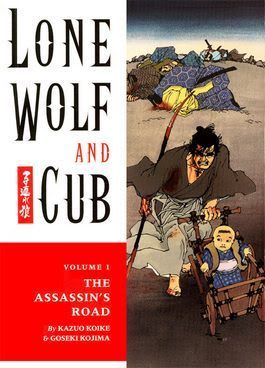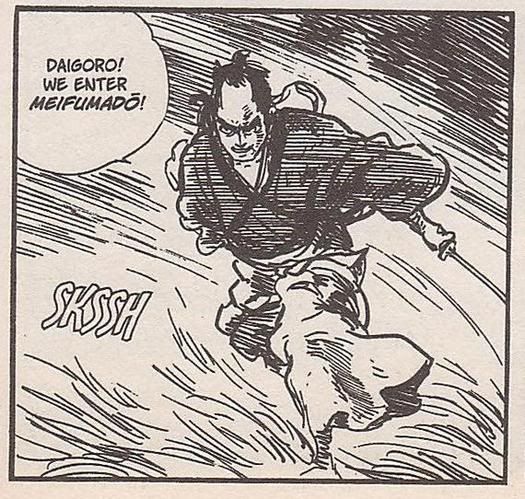 Lone Wolf & Cub Vol. 1: The Assassin's Road
Lone Wolf & Cub Vol. 1: The Assassin's RoadBy Kazuo Koike and Goseki Kojima
Published by Dark Horse; $9.95 US
304 pages
I keep looking for a new Lone Wolf & Cub and nothing seems to work. That isn't to say Kazuo Koike and Goseki Kojima hold a monopoly on good samurai vengeance stories. But Lone Wolf & Cub is unique. It isn't just a bloody, kick-ass comic whose inspirational mark you can find in other comics, in hip-hop albums, in Quentin Tarantino films, in cartoons, in video games, and even in a Tom Hanks movie. It's an epic adventure highlighting the horror and beauty of Edo-period Japan. It's a story constantly asking which is more important: the path you choose or how you walk it. Most importantly it's a story about an unbreakable bond between a father and a son.
Before Wolverine or Kill Bill's Beatrix there was Ogami Itto. Itto is the Shogun's loyal executioner until he's framed for treason and his family is slaughtered. Itto becomes Japan's deadliest assassin on his quest for vengeance. Known as Lone Wolf and Cub, Itto often employs his toddler son Daigoro in his killings. Sometimes he uses the child as bait, sometimes as a distraction, and other times even as a shield. While it seems heartless and cruel on the surface, as Itto tells the ronin Furizue Geki in this first volume, "a father knows his child's heart, as only a child can know his father's. No stranger can understand."
Fittingly, I read Lone Wolf & Cub Vol. 1: The Assassin's Road in a waiting room as my oldest nephew was being born. It was one of the first manga I'd read. I bought it specifically because I wanted to dip my toe into the world of manga, and while I liked what I saw I wasn't ready to dive in just yet. I can't say it left much of an impression just then. On one hand, my mind was on other things. On the other, while it was good and I wanted to read more, it was easy to get confused in the minutiae of Japanese feudal intrigue. Each volume of Lone Wolf & Cub includes a glossary explaining the meanings of any untranslated words. Still, glossary or no glossary, exposition scenes between Itto and his clients - with the clients explaining the reasons they were hiring him - often went over my head. I was often resigned to appreciating the artistry with which Kojima depicted the bloodletting without necessarily understanding why Itto was fighting anyone.
Having now read all 28 volumes and officially deeming Lone Wolf & Cub my favorite comic book series of all time, it is difficult to re-read The Assassin's Road without noticing what is so strikingly different between these early stories and what came later.
For one thing, the stories are much shorter. Most of the stories in the other 27 volumes were around 60 pages while only one piece - "Wings to the Bird, Fangs to the Beast" - reaches that length in The Assassin's Road.
Itto is certainly not as fully realized here. Physically he doesn't seem as taut or as ragged. There are panels in which Itto's face actually betrays a hint or two of chubbiness. Itto's characteristic stoicism and unflappability are absent at first. When he reveals his trap in "Sword for Hire, Son for Hire," for example, he laughs triumphantly at his prey and overall enjoys the victory of his deceit whereas the future Itto would reserve that kind of sadistic joy for only his most hated foes, usually seeming simply to accept and endure the consequences of his darkest acts.
The notion of Daigoro participating in the assassinations seems more compulsory in this first volume. While this was an element that never left the series entirely, it becomes less of an automatic plot point. I got the sense that perhaps Daigoro's help was a gimmick that sold the series to publishers, but became less necessary as it garnered success. At the very least, Daigoro's contributions to the killings are treated in a much lighter manner in The Assassin's Road than they would later. In "Suio School Zanbato," Itto tricks Bessho Mondo into a formal duel by instructing his son to stand on a ridge overlooking the road to pee on Mondo's head. In the beginning of "A Father Knows His Child's Heart, as Only A Child Can Know His Father's" - when Itto lures an unsuspecting ronin into water by telling Daigoro to pretend he's drowning - Daigoro seems absolutely oblivious to the murder he just aided when his father lifts him out of the water. He smiles and reaches out for his father as if they were playing in their own backyard pool.
While Goseki Kojima doesn't have the time and space in The Assassin's Road for the kind of expansive landscapes that litter the rest of the series, the cinematic perspective of this first volume is perfect. What impresses me perhaps more than anything else about the late Kojima's work is how he engages my senses. In particular, more than any other comic, I hear Lone Wolf & Cub. There is something about Kojima's elegant sense of timing and his understanding of the natural world that truly makes me experience the sounds of the story. At the end of "Sword for Hire, Son for Hire," when Itto halves a tree while disposing of his target's protectors, I really hear the tree's weight and girth crashing to the ground; just as I hear the metallic unsheathing of swords before Itto's duel with Bessho Mondo in "Suio School Zanbato."
As jarring as the comic book corners of the Internet can be, there isn't much about those corners that surprises me more than how little there is dedicated to Lone Wolf & Cub (and much of what's out there has more to do with the film adaptations). I guess I shouldn't be too shocked that I can spit in the air and hit a Spider-Man fansite, yet finding anything significant about Lone Wolf & Cub takes some real digging. It's in part because of this void that in the coming weeks I'm going to do something I've wanted to do ever since I started blogging about comics: I'm going to review every volume of Lone Wolf & Cub. I won't lie. Not all volumes are equal. There may be a few reviews where I'll struggle to say something more than, "Itto killed some dudes, Daigoro's cute, and there was some really bizarre sex," but hey. The challenge is part of the fun. When all else fails, I can just be a smartass.


No comments:
Post a Comment